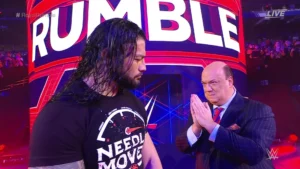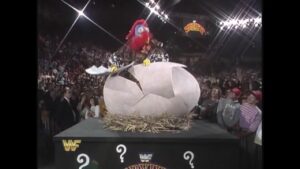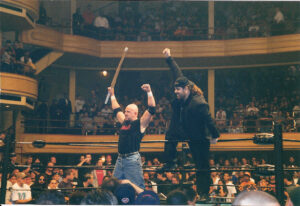It was on April 28, 2005, that the pro wrestling world was stunned to hear of the passing of former WWE, ECW, and WCW Superstar Chris Candido. Candido had gone to the hospital after feeling ill only to discover he had pneumonia. His condition worsened through the day and despite efforts to drain his lungs, he passed away that evening (while some stories claim Candido died from a blood clot in his leg, his brother Jonny has stated it was from “acute pneumonia”). He was only 33 years old. While his runs in WWE and WCW never quite took off like expected, Candido’s effect on the rising indie scene in the United States in the 1990s had a lifelong impact.

Growing up in New Jersey, Candido and his high school friend Jonathan Rechner (who would go on to become Balls Mahoney in ECW) would hang around the local indie and help set up the ring, and when Candido turned 14 in 1986, they began training at Larry Sharpe‘s Monster Factory. It was around this time that he would meet his lifelong companion, Tammy Lynn Sytch (aka Sunny in WWF) while attending Red Bank Catholic High School in New Jersey. Candido would work the local promotions, such as Sharpes’ World Wrestling Association (WWA), until joining Jerry Lawler and Jerry Jarrett‘s United States Wrestling Association (UWSA) in 1991 as a 19-year old.
Candido’s stint in UWSA was brief, and in early 1992 he headed to Japan where he competed for Atsushi Onita‘s Frontier Martial-arts Wrestling (FMW) for a two-month tour as The Blonde Bomber, fighting with such FMW staples as Ricky Fuji and Tarzan Goto, and teaming with another young star in Sabu, whom Candido knew from back in the US indies.
https://www.youtube.com/watch?v=A-0b3irV6N8
In 1993, Candido – with Sytch as his valet – signed with Jim Cornette‘s Smokey Mountain Wrestling (SMW) in Tennessee, where he would see his stock rise in the United States market. In his first year, he became a 3x SMW United States Junior Heavyweight Champion and SMW Beat the Champ Television Champion. He also began working for Eastern Championship Wrestling (ECW), where he would become 2x ECW Tag Team Champions alongside Johnny Hotbody and Richard (Chris) Michaels in The Suicide Blondes, utilizing the Freebird rule.
https://www.youtube.com/watch?v=Pt0NAMvHhN8
In 1994, Chris Candido formed a new tag team in SMW alongside Brian Lee, defeating the Rock N’ Roll Express for their first SMW Tag Team Championships in April. After losing their second title reign as tag team champs, Sytch fired Lee from the team and Candido was once again pushed as a singles star. That fall, he returned to Japan for another tour, but this time worked for All Japan Pro Wrestling (AJPW), where he primarily tagged with former NWA World Champion Dory Funk Jr.
https://www.youtube.com/watch?v=Lf4wjJ2ToCM
Upon his return from Japan, he had the biggest moment of his career thus far, when he was entered into a tournament to crown the new NWA World’s Heavyweight Champion. The National Wrestling Alliance (NWA) was experiencing its worst luck in years that calendar year – in September of 1993, World Championship Wrestling (WCW) withdrew from the NWA, and in doing so, lost Ric Flair as their World Champion. The NWA tagged ECW to be one of the new standard bearing promotions of the organization, but following a tournament to crown the new World Champion in August, eventual winner Shane Douglas announced that ECW was also departing the NWA and rebranding from Eastern to Extreme and that he was now the new ECW World Heavyweight Champion instead. In just under a year, the NWA lost both WCW and ECW, as well as two World Champions. The new World title tournament was held in alliance with SMW, and Chris Candido defeated Al Snow and Dirty White Boy to advance to the finals, where he would ultimately defeat Tracey Smothers to become the new NWA World’s Heavyweight Champion.
Candido’s reign as NWA World Champion would brief, only 97 days, and on February 24, 1995, he lost the belt to rising MMA and UFC star Dan “The Beast” Severn. He would go on to have a Loser Leaves Town match in SMW two days later, where he lost to former tag partner Boo Bradley. It was ultimately revealed that Candido, alongside Sytch, had been signed by the World Wrestling Federation (WWF).
Chris Candido debuted on WWF TV on June 3, 1995’s episode of WWF Superstars, where he defeated a pre-“Scotty 2 Hotty” Scott Taylor. He debuted as a fitness athlete named Skip, while Sytch was renamed to Sunny, and followed it up two days later on Monday Night Raw with another victory, over Barry Horowitz. Oddly enough, Skip would become perennial jobber Horowitz’s first real “feud” in WWF, and on the July 9 episode of WWF Wrestling Challenge, Horowitz scored his first WWF win over him. The feud would continue into SummerSlam, where Horowitz would beat Skip once again.
It would mark Skip’s first losses in the WWF since his debut and while he would go on to bigger opponents, like Shawn Michaels, Marty Jannetty, and the 1-2-3 Kid, the losses would continue. In late 1995, they would finally begin to work on Skip’s personal trainer aspect of his character, taking on portly Rad Radford (ECW’s Louie Spicolli) as his new project, or “Bodydonna in training”. Soon, the trio became a quartet, when Tom Pritchard, formerly of early 90s WWF tag team The Heavenly Bodies, joined as Skip’s cousin, Zip, and the Bodydonnas were born. The trio competed at Survivor Series 1995, but Radford was soon ejected from the group as a lost cause, with Skip and Zip moving on as a tag team.

In March of 1996, the Bodydonnas finally became WWF World Tag Team Champions, defeating The Godwinns for the vacant titles at WrestleMania XII in Anaheim, California. But their WrestleMania moment was just that, and 49 days later, they lost the titles to the Godwinns at a WWF Live Event at Madison Square Garden. Following the loss, Sunny would turn on them as her manager, joining the Godwinns briefly at first, before aligning with The Smoking Gunns (Bart & Billy Gunn). The Bodydonnas would feud for the bulk of the year against both teams, but by the fall, Candido had had enough and left the WWF. Following a Bodydonnas loss to the British Bulldog & Owen Hart on the September 23, 1996 edition of Raw, Candido departed the company.

Candido wasn’t out of work for long. Just over a month after leaving WWF, Candido returned to ECW – now Extreme Championship Wrestling – and re-debuted at ECW High Incidents on October 26, defeating Spike Dudley. There Candido got a chance to shine and remind fans of his true potential. During his return to ECW, he would have his final match with the WWF, in a showcase of both ECW and USWA, as he faced Brian Christopher. He would join Shane Douglas’ second incarnation of Triple Threat, alongside Brian Lee. Lee would ultimately be replaced by Bam Bam Bigelow, who would win the ECW World Heavyweight title and feud with Candido that fall. Bigelow was briefly replaced by Lance Storm, and while Candido and Storm had an uneasy alliance but managed to capture the ECW World Tag Team titles in December of 1997.

In July of 1998, Sytch was released from the WWF and rejoined Candido in ECW, and by 1999, he was feuding against Taz for the ECW World title. But by the end of 1999, he was tagging with newcomer Rhino more frequently, and following failure to defeat the Impact Players (Lance Storm & Justin Credible) for the ECW tag titles on ECW on TNN on December 17, Candido departed from ECW. He would initially sign on with California’s Xtreme Pro Wrestling (XPW), a new hardcore promotion that started in 1999 to compete with ECW’s cult following for violence, alongside another new promotion, Combat Zone Wrestling (CZW) in 1998. He debuted at XPW Abuse of Power in January of 2000, defeating Damien Steele.
His stay with XPW was a short one, and in May of 2000, he and Sytch signed with World Championship Wrestling (WCW), where he was immediately thrown into a rebooted Cruiserweight division as part of The New Blood stable featuring new or underutilized talent. At WCW Spring Stampede a month later, he became the new WCW Cruiserweight Champion. When the New Blood angle fizzled by the end of the summer, so did Candido’s plans in the Cruiserweight division, and he was briefly reunited with Shane Douglas and Bam Bam Bigelow in a WCW reboot of Triple Threat. But by June of 2000, he was gone from the company.

For years, Chris Candido and Tammy Lynn Sytch had been leading a dark life, and that substance abuse was spiraling out of control. Pushes and employment had come as a result of their lifestyles, and one of the most promising young stars of the 1990s was on the verge of destroying his career. According to his brother Jonny in an interview, depression and an addiction to somas (pain killers) had taken its toll on Candido mentally and physically.

Attempting to salvage his career, Candido returned to Japan, this time with New Japan Pro Wrestling (NJPW). He debuted with NJPW that spring at the Best of the Super Juniors VIII in 1991, but he failed to leave his A Block that featured eventual winner Jushin ‘Thunder’ Liger. He would continue to work for New Japan for the remainder of the year, as well as some return dates with his old Japan home, FMW. He left New Japan in February of 2002, and returned to the US independent circuit. He would also begin working in Puerto Rico, with Carlos Colon’s World Wrestling Council (WWC).
He returned to XPW and made his IWA Mid South debut in early 2002, debuting against a rising prospect in Chris Hero. He also began working with upstart indie promotion Major League Wrestling (MLW), facing Terry Funk at MLW Reload on September 26. Slowly he rebuilt his name in the rising revolution of the US indie movement, working with the likes of Jersey Championship Wrestling (JCW, which became Game Changer Wrestling in 2015), Jersey All Pro Wrestling (JAPW), Impact Championship Wrestling (ICW New York), Full Impact Pro (FIP), and International Wrestling Cartel (IWC).
By late 2004, Candido had managed to regain control of his life and had cleaned up his demons, and signed with TNA/IMPACT Wrestling. He made his debut with TNA in January of 2005 against AJ Styles and soon found himself leading a stable that included The Naturals (Chase Stevens & Andy Douglas). On April 24, at TNA Lockdown, Candido and Lance Hoyt teamed up to face Sonny Siaki & Apolo, but tragedy would strike. During a free accident, Siaki landed on Candido awkwardly during the match, breaking Candido’s leg. Candido returned to the next tapings on April 26, accompanying The Naturals in a wheelchair, as they won the NWA World Tag Team titles from America’s Most Wanted (“Wildcat” Chris Harris & “Cowboy” James Storm). Two days later, Chris Candido was dead. His final appearance with TNA would air on April 29, the day after his death.
Chris Candido’s athleticism in the ring was a thing of marvel for much of the 2000s and his frustration with getting proper recognition on national platforms, coupled with long-standing substance abuse, kept Candido from making a bigger name for himself in mainstream professional wrestling. While the industry was adapting to smaller guys, at 5’8″ and 225 lbs., he was still considered too small for WWF at the time to be pushed like he would in today’s WWE climate, where equally sized stars like Daniel Bryan and Adam Cole have found success. His resurgence with New Japan at the 2001 Best of the Super Juniors and a return to television with TNA could have helped Chris Candido become a mentor to the impending indie revolution in the US, with the likes of Ring of Honor, Pro Wrestling Guerrilla (PWG), and others who were filled with young stars who had grown up emulating the smaller stature of Candido during his stints with USWA, SMW, WWE, ECW, and WCW. But instead, Candido has been reduced to a cult-status figure, adored by the hardcore fans, remembered by his peers and proteges, as one of the most underrated and underutilized wrestlers of the 1990s.
Stay tuned to the Last Word on Pro Wrestling for more on this and other stories from around the world of wrestling, as they develop. You can always count on LWOPW to be on top of the major news in the wrestling world, as well as to provide you with analysis, previews, videos, interviews, and editorials on the wrestling world.






